Choosing the right kitchen cabinet material is crucial for both style and functionality. Whether you’re remodeling your kitchen or designing one from scratch, understanding the various types of kitchen cabinet materials can help you make an informed decision. This comprehensive guide explains the pros, cons, and ideal use cases of each popular material to help you find the best fit for your home.
1. Solid Wood
Overview: Solid wood cabinets are made entirely from natural wood such as oak, maple, cherry, or walnut.
Pros:
- Highly durable and long-lasting
- Easily repairable
- Classic and luxurious appearance
Cons:
- Expensive
- Susceptible to warping with moisture
Best For: Traditional and high-end kitchens
2. Plywood
Overview: Plywood is made from thin wood layers glued together, offering strength and stability.
Pros:
- Strong and moisture-resistant
- Lighter than solid wood
- Cost-effective
Cons:
- More expensive than particleboard
- Edges may require finishing
Best For: Custom cabinets and humid climates
3. Medium-Density Fiberboard (MDF)
Overview: MDF is an engineered wood product made from fine wood fibers and resin.
Pros:
- A smooth finish is ideal for paint
- No grain, which means no cracking or warping
- Cost-effective
Cons:
- Not water-resistant
- Can sag under heavy loads
Best For: Painted cabinets and modern kitchens
4. Particle Board
Overview: Composed of wood particles and resin, particleboard is the most budget-friendly option.
Pros:
- Affordable
- Lightweight
- Easy to install
Cons:
- Prone to damage from moisture
- Less durable
Best For: Rental properties and low-budget renovations
5. High-Pressure Laminate (HPL)
Overview: HPL is a decorative surface bonded to a substrate like MDF or particleboard.
Pros:
- Scratch-resistant and durable
- Available in a wide range of colors and finishes
- Easy to clean
Cons:
- Can be costly
- Limited to modern styles
Best For: Contemporary kitchens and high-use environments
6. Thermofoil
Overview: Thermofoil is a vinyl laminate that is heated and molded over MDF.
Pros:
- Affordable with a sleek finish
- Low maintenance
- Moisture-resistant
Cons:
- Can peel or discolor over time
- Sensitive to heat
Best For: Budget-friendly, modern-style kitchens
7. Stainless Steel
Overview: Stainless steel cabinets are typically used in commercial kitchens but can also make a bold statement in residential spaces.
Pros:
- Incredibly durable
- Heat and moisture-resistant
- Hygienic and easy to clean
Cons:
- Expensive
- Can show fingerprints and scratches
Best For: Industrial and professional-style kitchens
Frequently Asked Questions (FAQs)
What is the most durable kitchen cabinet material?
Which cabinet material is best for moisture-prone areas?
Are MDF cabinets of good quality?
. What is the cheapest kitchen cabinet material?
How do I choose the right material for my kitchen cabinets?
Conclusion
Understanding the different types of kitchen cabinet materials helps you strike the right balance between aesthetics, durability, and cost. Whether you’re looking for a timeless solid wood look or a modern, low-maintenance finish, there’s a material to suit every kitchen and budget. Choose wisely to enhance your kitchen’s value and functionality.

